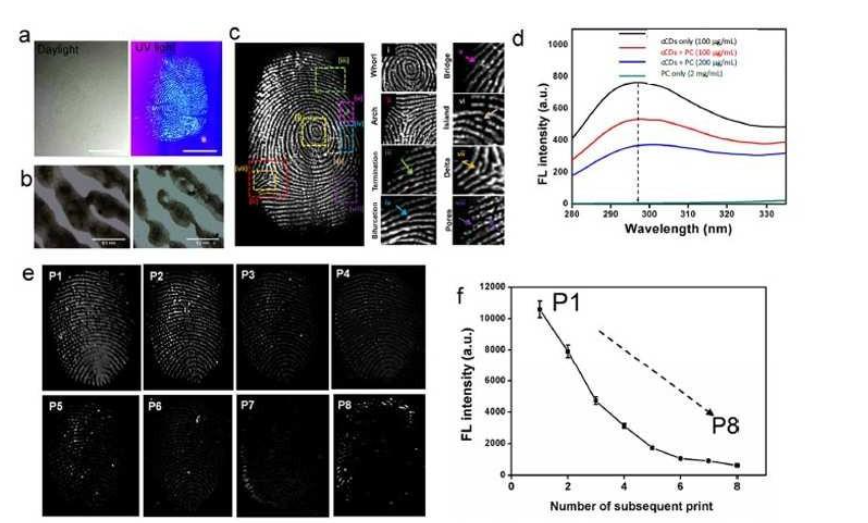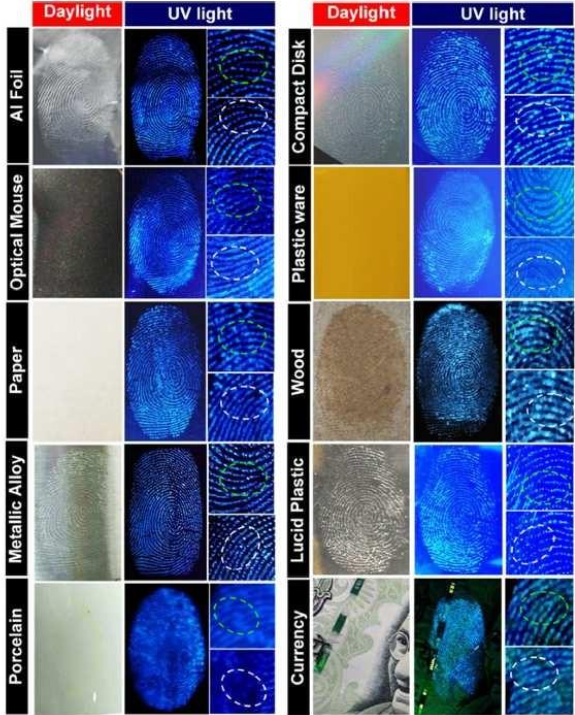The present invention provides a method for the preparation of Carbon Dots (CDs) for use in fingerprint detection and anti-counterfeiting applications. The method involves a simple and rapid microwave-assisted synthesis using citric acid and polyethyleneimine as carbon and nitrogen precursors, respectively. The resulting CDs exhibit strong fluorescence and cationic surface properties, making them highly suitable for adhering to fingerprint residues and security substrates. The synthesized CDs enable clear, high-contrast visualization of latent fingerprints and can be effectively used in anti-counterfeiting inks or coatings. This approach offers a cost-effective, scalable, and efficient solution for forensic and security technologies.
Figure (1a) Fingerprint development on a non-greasy glass substrate as seen in daylight and UV light (375 nm); (1b) Bifurcation and termination of the ridges seen in 4X under an optical inverted microscope; (1c) Representative grey scale image of a fluorescent fingerprint pattern developed using cCDs. Various features are marked (i-viii) with respective colour codes. The pattern shows clear differences in the features that can be extracted from the image; (1d) Fluorescence emission spectra (excited at 250 nm) of the cCDs in the presence of lipid (phosphatidyl choline, 60%); (1e) Images showing fingerprint patterns till 8 consecutive press stamps used for intensity calculation; Changes in the fluorescence intensity of cCDs after a number of iterative press stamps (P, from P1-P8); (2) cCDs based fingerprint developed on various solid surfaces and their second-level detail characterization for termination and bifurcation. The area under green dotted circles denotes bifurcation and white circles for termination; Publication: Bahadur, Rohan, et al. "Multi-fluorescent cationic carbon dots for solid-state fingerprinting." Journal of Luminescence 208 (2019): 428-436.
There continues to be a need for a simple and less time-consuming process for preparation of CDs that do not use toxic and expensive precursors and harsh acids, and yields CDs that are cationic in nature, in high quantum yields.
- Rapid Synthesis within 30 Minutes: The CDs are prepared using a microwave-assisted one-pot method that significantly reduces synthesis time compared to conventional methods.
- Cost-Effective and Equipment-Free Process: The process avoids the use of expensive, heavy setups, making it suitable for scalable, low-cost production.
- Use of PEI as a Nitrogen Precursor: Polyethyleneimine (PEI) provides a stable positive charge and greatly enhances fluorescence, unlike traditional nitrogen sources like ammonia, urea, or nitrate.
- High Quantum Yield and Bright Fluorescence: The method yields CDs with strong, stable photoluminescence and a high quantum yield (up to 46.5%), ideal for imaging applications.
- Positively Charged CDs for Better Fingerprint Binding: The cationic nature of the CDs allows stronger adhesion to anionic fingerprint residues, giving superior image contrast.
The present invention provides a method for preparing Carbon Dots (CDs) using a simple and efficient process. Initially, citric acid is added to polyethyleneimine (PEI) in a weight-to-weight ratio ranging from 10:1 to 2:1 and mixed thoroughly for 5 to 15 minutes. The resulting mixture is then subjected to microwave heating for a duration of 30 to 40 minutes, leading to the formation of a carbonized material. This carbonized product is washed with a suitable solvent to yield a dark brown precipitate. Finally, the precipitate is centrifuged at speeds between 15,000 and 25,000 rpm, and the supernatant is collected, which contains the desired CDs.
Technology synthesized and published in proof-of-concept.
3
This invention offers a low-cost, rapid, and safe method to produce highly fluorescent carbon dots for forensic and anti-counterfeiting applications. By enabling clear and lasting fingerprint visualization without toxic materials or complex setups, it enhances public safety and crime investigation capabilities. The environmentally friendly process also supports scalable manufacturing for widespread use in law enforcement and security sectors.
- Forensic science and criminal investigation
- Anti-counterfeiting and document security
- Nanomaterials and fluorescence imaging
- Chemical and materials engineering
- Security inks and authentication technologies
- Rapid diagnostics and biosensing systems
- Optical sensors and smart materials
Geography of IP
Type of IP
201721038918
477212


